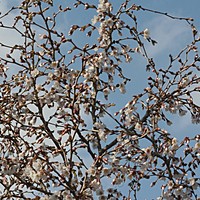Planting trees
If the weather forecast is anyway near accurate, we may all be up to our necks in snow by now. Writing this mid October, it is very hard to imagine as there are parts of the garden that could fool you into thinking it’s June. One little group Charnwood includes is a pink English Rose, several spikes of a rich blue delphininum, some green tobacco plant ‘Lansdorfii’ and tall pink Cosmos.
A tree can transform your garden, and November can be a good month for planting deciduous trees and shrubs, as long as a frost is not forecast. Bare root trees are cheaper and easier to transport, so a good alternative to the rather expensive pot grown specimens you tend to get in garden centres. Smaller trees tend to get established easier and more quickly than bigger ones. Soak the tree well for at least an hour before you plant. The latest research has found that the ground should be well cultivated, but no compost or fertiliser added. Cultivate the ground well to around 1.5 metres across, but no deeper than the rootball as most roots grow sideways and not downwards. You can buy ‘friendly’ funghi now from garden centres that encourages root growth. Don’t plant too low, or the tree will ‘settle’ and have difficulty breathing. Tease out the roots gently, make sure it’s upright and facing the right way in the planting hole and backfill thoroughly, firm in well and give it proper support, hammered well in to the ground away from the roots and facing into the prevailing wind so it survives the winter gales. Water really well and give it a mulch of shredded bark or leaf mould. Keep it well watered for at least the first year. My favourite trees include the willow leaved pear, Pyrus salicifolia ‘Pendula’ and the dwarf Fuji cherry Prunus incisa ’Kojo-no-mai’. Both have lovely spring blossom and the cherry gorgeous autumn colours.
Two of my usual ‘nags’ at this time of year – it’s not too late to plant tulips, and gather up your leaves to make leafmould. I’ve planted up some pots of the lovely lily flowered tulips; they are so elegant and come in gorgeous colours to suit any colour scheme. I’ve decided to be a bit more subtle this year, and have gone for ‘White Triumphator’ underplanted with forget me nots. I soaked the bulbs in tonic water with quinine last year and it seemed to stop the squirrels munching them to some extent, so I’ve done it again.
Making leaf mould is dead easy – put fallen damp leaves in a big plastic bag, tie the top, stab a few holes in the bottom with a fork and dump them behind the shed. In a year, or maybe two, you will have beautiful dark, crumbly compost, all for free. Plants that enjoy a mulch of this include lilies, hellebores and any woodland plant. If you mow the leaves off your lawn, the combination of them all chopped up with grass clippings composts really well and more quickly.
